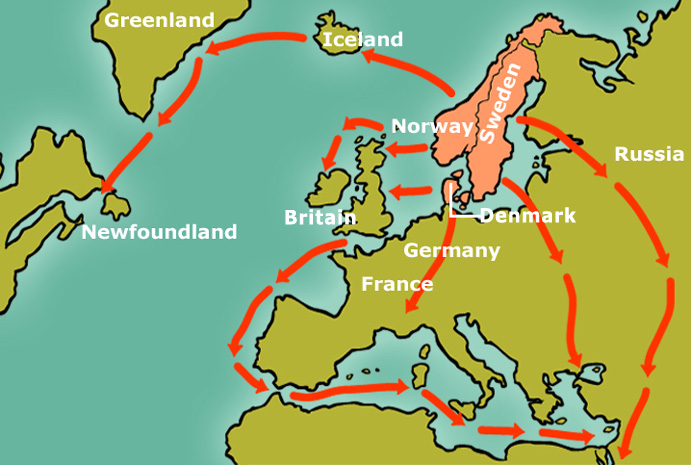A Mysterious Island, Incest and a Twelfth-century Papal Letter February 21, 2013
Author: Beach Combing | in : Medieval , trackbackGreenland certainly had contact with the New World in the late tenth century. Did though this contact continue into the eleventh, twelfth, thirteenth, fourteenth and fifteenth century? This controversy is one we have looked at before, showing that there is some evidence that it did: though the evidence is intermittent. Here is a further document that might be relevant, though here the evidence is far less certain and depends on an error in this letter of 1160 from Pope Alexander III to the Archbishop of Trondheim: as so often it is an answer to a now missing letter which may conceivably survive in the Vatican.
Through the news considerately conveyed by your messengers, it has been made known to us that there lies an island twelve days’ journey and more from Norway, and which is subject to your metropolitan authority. The parishioners there on the island are said to be so near in consanguinity and affinity that they can hardly contract marriage legally in accordance with the statutes of Canon Law… But if it is as we heard that the above mentioned island lies twelve days’ journey from other lands, and you know for certain that the islanders live in such great difficulties with regard to this then you may inform your bishop and with the advice of yourself and other religious men give dispensation and allow the aforementioned people to contract marriage in the fifth, sixth and seventh degree…
Ex diligenti relatione nunciorum tuorom nostris est auribus intimatum, quod insula quedam a Norwegia per xii dietas et amplius distats posita esse et metropolico iure tue ditioni subesse perhibetur, cuius itaque parrochiani ita se consanguinitate uel affinitate dicuntur contingere, quod matrimonium uix secundum statuta canonum legitime possint contrahere . . , Verumtamen si ab aliis insulam prescriptam terris per xii dietas sicut audiuiinus constet distare et eius populo tantam in hiis necessataitem noueris iminere, tu ascitis tibi suffraganeis tuis cum suo et aliorum religiosorum uirorum consilio poteris dispensare et supradicto populo, ut in v et vi et vii gradu conitrahant matrimonium.
There is a second transcript with some slight variations that includes the information that the poor could not leave this island to find marriages elsewhere et pauperibus fere impossibile).
What was this island? The two obvious candidates would be Iceland or Greenland. However, as long ago as 1959 Eirik Vandvik suggested that the ‘obvious’ choices were wrong and that the letter describes a twelfth-century colony in the New World. The evidence that was and that has been marshalled to justify this conclusion have included the following points.
(i) Neither Greenland or Iceland are twelve days journeys from Norway. However, it has been suggested that a Canadian settlement in Newfoundland (L’Anse-aux-Meadows) would be about twelve days journey from the Eastern Settlement on Greenland. This would mean that the pope had got confused about some of the information he was given perhaps mixing up the seat of the archbishop (Norway) with the seat of the bishop (Greenland).
(ii) In Iceland and Greenland (even in the Western Settlement) there should really have been enough people to avoid serious problems of intermarriage, at least down at the fourth and fifth degrees.
(iii) The papacy would have known all too well the names Greenland and Iceland, whereas the ‘quedam insula’ suggests a very vague location.
(iv) Greenland was not considered an island in the twelfth century.
This evidence does not seem particularly convincing to Beach. Taking the points one by one, there is clearly a mistake in the twelve days that could be explained by a whole series of different explanations. The problems of consanguinity would have cropped up anywhere in the medieval world where there was a priest capable of making calculations: rural communities – ‘small worlds’ – inevitably break these rules. The absence of Iceland or more probably Greenland could be explained by simple papal laziness: how do you spell that, oh sod it…. As to Greenland not being considered an island, there are earlier examples of it being so described and this could again just be a papal way of dealing with information about a place out in the Atlantic. Still an intriguing document with intriguing possibilities. Other opinions: drbeachcombing AT yahoo DOT com



